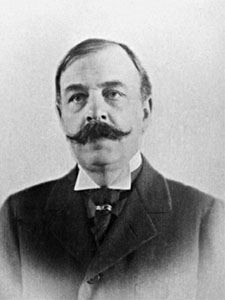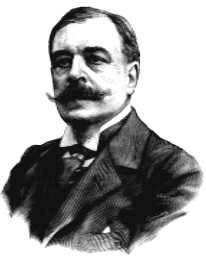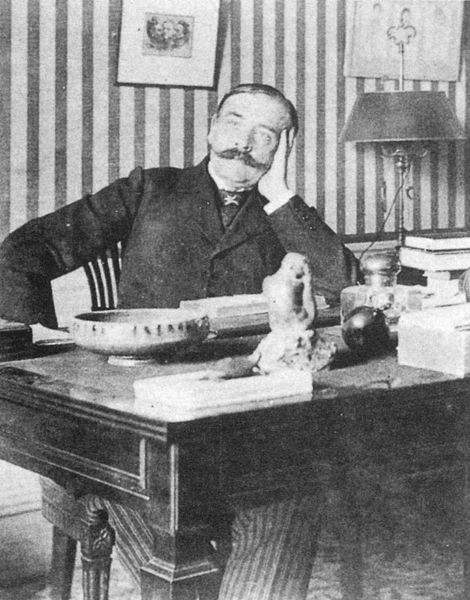<Back to Index>
- Anthropologist Francis Galton, 1822
- Author Octave Mirbeau, 1848
- Supreme Leader of DPR Korea Kim Jong-il, 1941
PAGE SPONSOR



Octave Mirbeau (February 16, 1848 in Trévières, Calvados - February 16, 1917) was a French journalist, art critic, pamphleteer, novelist, and playwright, who achieved celebrity in Europe and great success among the public, while still appealing to the literary and artistic avant-garde. His work has been translated into thirty languages.
Mirbeau spent his childhood in a village of the Normandy, Rémalard, pursuing secondary studies at a Jesuit college in Vannes, which expelled him at the age of fifteen. Two years after the traumatic experience of the 1870 war, he was tempted by a call from the Bonapartist leader Dugué de la Fauconnerie, who hired him as private secretary and introduced him to L'Ordre de Paris.
After his debut in journalism in the service of the Bonapartists, and his debut in literature when he worked as a ghostwriter, Mirbeau began to publish under his own name. Thereafter, he wrote in order to express his own ethical principles and aesthetic values. A supporter of the anarchist cause and fervent supporter of Alfred Dreyfus, Mirbeau embodied the intellectual who involved himself in civic issues. Independent of all parties, Mirbeau believed that one’s primary duty was to remain lucid.
As an art critic, he campaigned on behalf of the “great gods nearest to his heart”: he sang the praises of Auguste Rodin, Claude Monet, Camille Pissarro, Paul Cézanne, Paul Gauguin, Auguste Renoir, Félix Vallotton, and Pierre Bonnard, and was an early advocate of Vincent Van Gogh, Camille Claudel, Aristide Maillol, and Maurice Utrillo (Combats esthétiques). As a literary critic and early member of Académie Goncourt, he 'discovered' Maurice Maeterlinck and Marguerite Audoux and admired Remy de Gourmont, Marcel Schwob, Léon Bloy, Georges Rodenbach, Alfred Jarry, Charles-Louis Philippe, Émile Guillaumin, Valery Larbaud and Léon Werth (Combats littéraires).
After authoring ten ghostwritten novels, he made his own literary debut with Le Calvaire (Calvary, 1886), in which writing allowed him to overcome the traumatic effects of his devastating liaison with the ill-reputed Judith Vimmer, renamed Juliette Roux in the novel. In 1888, Mirbeau published L'Abbé Jules (Abbé Jules), the first pre-Freudian novel written under the influence of Dostoyevsky to appear in French literature; the text featured two main characters: l’abbé Jules and Father Pamphile. In Sébastien Roch (1890) (English translation : Sébastien Roch, 2000), Mirbeau purged the traumatic effects of his experience as a student at a Jesuits school in Vannes. In the novel, the 13-year old Sébastien is sexually abused by a priest at the school and the abuse destroys his life.
Mirbeau then underwent a grave existential and literary crisis, yet during this time, he still published in serial form a pre-existentialist novel about the artist’s fate, Dans le ciel (In the Sky), introducing the figure of a painter directly modeled on Van Gogh. In the aftermath of the Dreyfus Affair -
which exacerbated Mirbeau’s pessimism - he published two novels judged
to be scandalous by self-styled paragons of virtue : Le Jardin des supplices (Torture Garden (1899) and Le Journal d'une femme de chambre (Diary of a Chambermaid) (1900), then Les Vingt et un Jours d'un neurasthénique (1901). In these works, Mirbeau unsettled traditional novelistic conventions, practicing the technique of collage, transgressing the code of verisimilitude and fictional credibility, and defying the hypocritical rules of propriety. In his last two novels - La 628-E8 (1907) and Dingo (1913), he strayed ever further from realism, giving free rein to fantasy elements and casting his car and his own dog as heroes. Because of the
indeterminacy of their genre affiliation, these last Mirbeau stories
show how completely he had broken with the conventions of realist
fiction. In the theatre, Mirbeau made his first steps with a proletarian drama and modern tragedy, Les Mauvais bergers (The Bad Shepherds, 1897). Then he experienced worldwide acclaim with Les affaires sont les affaires (Business is business 1903) - his classical comedy of manners and characters in the tradition of Molière.
Here Mirbeau featured the character of Isidore Lechat, predecessor of
the modern master of business intrigue, a product of the new world, a
figure who makes money from everything and spreads his tentacles out
over the world. In 1908 - at the end of a long legal and media battle - Mirbeau saw his play Le Foyer (Home) performed by the Comédie-Française.
In this work, he broached a new taboo subject, the economic and sexual
exploitation of adolescents in a home that pretended to be a charitable
one. He also wrote six one act plays, published under the title of Farces et moralités (1904), among them being L'Épidémie (Epidemics). Here, Mirbeau can be seen as anticipating the theatre of Bertolt Brecht, Marcel Aymé, Harold Pinter, and Eugène Ionesco.
He calls language itself into question, demystifying law, ridiculing
the discourse of politicians, and making fun of the language of love. Mirbeau
has never been forgotten, and there has been no interruption in the
publication of his works. Yet his immense literary production has
largely been known through only three works, and he was considered as
literarily and politically incorrect. But,
more recently, Mirbeau has been rediscovered and presented in a new
light. A fuller appreciation of the role he played in the political,
literary, and artistic world of la Belle Epoque is emerging. Mirbeau lies buried in Passy Cemetery, in the XVIe arrondissement of Paris.